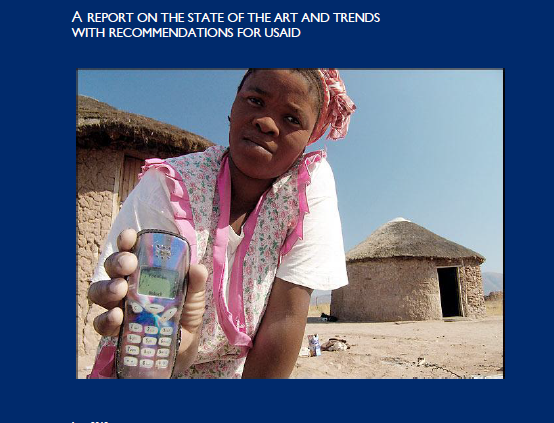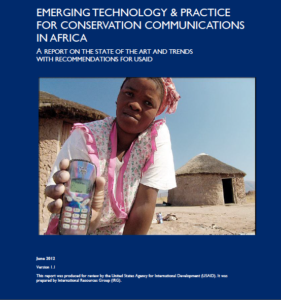USAID: ICT for Conservation Good Practices Should Be Institutionalized
A key recommendation by a USAID report that was released in June and titled “Emerging Technology and Practice for Conservation Communications in Africa” is for international development agencies to institutionalize good practice in the use of ICTs for Conservation. The report noted that while the conservation community has a wealth of experience in harnessing ICTs and communications among its many members, the distribution of this expertise is uneven.
It goes on to say that, opportunities exist to learn within the conservation community as well as learning from others operating in different fields but with similar ICT requirements. The study, which was led by a team of researchers from International Resources Group (IRG) based in Washington DC, took a very broad approach to emerging technologies for the general growth and development in Africa. While the focus of the study was on the conservation sector, other ‘non-conservation’ sectors such as finance, agriculture, health, governance, knowledge management and e-learning were touched on.
Some of the key findings from the research include:
On the plus side,
a) There is an increasing diversification of ICT devices and software combined with falling costs for equipment and subscriptions across much of sub-Saharan Africa in less than a decade.
b) A steady increase in the use of ICTs for conservation is seen in the area of management of research and monitoring data, remote sensing and communications, public awareness and education in the region.
c) The use of ICTs and especially mobile phone apps is prominent in transactions-based applications, such as electronic payments systems, mobile money and supply and value chain relationships.
d) Specifically, the kinds of ICTs used and the way in which they are used by the Central Africa Regional Program for the Environment (CARPE) and Sustainable and Thriving Environments for West African Regional Development (STEWARD) has been largely influenced by the mission of each program, the geographic scope, the stakeholders involved and the communication and knowledge sharing strategies that each program evolved.
On the minus side,
e) Due to costly infrastructure and the relative unavailability of cable and satellite feeds the spread of high bandwidth Internet has been slow, though this may change within the next decade.
f) The use of ICT directly in conservation activities in the region has been limited due to relatively remote and undeveloped nature of conservation sites in the region.
How Consistent are the Results of this Study with Others?
From these findings, it is clear that ICTs have come to stay and the onus is on the international development agencies to make it work. These findings reinforce other preceding studies that highlighted the growing importance of ICTs, and mobiles for conservation and development in the emerging countries. On the importance of ICTs and social media, the World Bank noted that people across the globe do much more than chat and play games using the emerging technologies. They are using the technologies to learn where best to fish; to identify what market to sell their produce in; to trace cattle from pastures to supermarkets; to report illegal logging and misuses of local budget; to pay bills, send money back home, and receive cash transfers; to do business on mobile phones; to prevent violence against women and empower them in their communities; to get state-of-the-art schooling online; to remotely monitor and switch on irrigation pumps; and to make their voices heard and trigger change. On mobiles for conservation, Ken Banks and Richard Burge co-authored a report in 2004 titled “Mobile Phones: An Appropriate Tool For Conservation And Development?”. The authors argued at the time that mobiles are ‘leapfrogging’ the technological gap between the developed and developing world due to the greater impact of mobile phones in the developing countries that have had poor telecommunications infrastructure over the decades. This statement has been confirmed by a recent report released by the World Bank, which revealed that about 77 percent of the over 6 billion mobile subscribers globally, are in the developing nations as against 23 percent in the developed nations. These are attestation to how communication technologies can dramatically influence almost every sector of the world’s economy.
Conclusion
In conclusion, the report noted that as Internet and high-density mobile networks spread across the African continent, it is highly likely that ICTs will play an increasing role in conservation activities. In order to institutionalize good practices therefore, agencies and development practitioners engaged in the design and implementation of Natural Resource Management (NRM) projects need to collaborate to systematically incorporate the use of ICTs in projects from project design through closure. They should build on networks of practitioners already recognized by their membership in communities supporting conservation. A successful example cited by the report is the Africa Biodiversity Collaborative Group (ABCG), a community with strong representation of practitioners and a history of information sharing on conservation in Africa. There should be continuous dialogue on emerging technologies to educate and to develop field requirements. The use of requirements analysis at the outset of activity planning to calibrate human resources and technology investments properly against overall goal achievement should be a key component of institutionalizing good practice. Finally, knowledge management and learning through local use of multimedia such as low-cost technologies to bring together text, video and audio for learning associated with all aspects of program implementation for conservation.







































